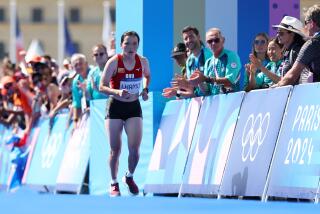She Runs on Heart, Prosthesis
- Share via
Sarah Reinertsen stood out among the 20,000 athletes who gritted, grunted and graced their way through the 26.2 miles of Sunday’s Los Angeles Marathon.
It wasn’t her time of just over six hours, more than four hours off the pace of the elite gazelles who placed in the race. But the Huntington Beach woman is fleet in her own field.
Reinertsen, 23, has one leg. She competes with a space-age version of a real one, and holds the women’s world marathon record--5:52:38--for an above-the-knee amputee.
But Reinertsen doesn’t run marathons to be noticed. She runs because it makes her feel like just another struggling athlete, not a disabled young woman.
“I don’t feel exceptional. I do what I do,’ she said, pulling back her long blond hair. “But I hope to be an example to some people who will say, ‘Look at that girl running on that crazy contraption. If she is out there, what is my excuse?’ ”
Reinertsen lost her left leg at 7 because of a tissue disorder that stunted its growth. It was amputated after a grueling decision she made with her parents. First outfitted with what she calls “clunky” prosthetics, she found it tough to compete in a world of the two-legged. Then she was fitted with a version of her current prosthetic. It was a turning point that led her to serious competition.
She recalls her first track meet for the disabled in 1988 on Long Island. It was a watershed moment.
“I looked around, and it was the coolest thing in the world; finally the cards were dealt evenly,” she said at home Saturday as she rested for the marathon. “I ran my little heart out, won and got hooked.”
Running for any amputee is difficult. Above-the-knee amputees have a particularly difficult path.
Reinertsen’s leg goes into a prosthesis--sort of a small plastic bucket--that has a hydraulic joint that mimics the knee. Attached just below is a specially designed “foot” for long-distance running. Made of carbon fiber by Flex-Foot of Aliso Viejo, it resembles an upside-down question mark that is flattened at the bottom. Glued to it is the tread from an old track shoe.
Running, as opposed to walking, means losing contact with the ground with both feet. Because Reinertsen lacks a normal knee joint, she must adopt unusual muscle movements to make the prosthesis function like a leg. In addition, she had to master the tricky task of simultaneously landing and balancing on the fake appendage.
If you watch her feet hitting the ground, her running appears slightly odd. But her gait is smooth and even, and she travels with just a slight hitch.
Reinertsen, who runs in a ponytail and pearls, is a compact 5 feet tall and weighs 98 pounds--”with my leg on.”
Her own leg is a wonder of form and muscle.
She charms everyone she meets--from seasoned track and field reporters to classmates at USC, where she is a journalism graduate student. The warm response she gets from people reflects her sunny and thoughtful demeanor and her inner strength rather than sympathy for her disability.
“The world expects more out of women athletes than men athletes,” said Bill Burke, president of the L.A. Marathon. “They expect them to be personable, feminine, charming and hopefully attractive, and you have to put all that on top of superior talent. She has all that.”
Marathon officials said she was the only one-legged runner they know of in Sunday’s race.
A New York native, she has run in three previous marathons. She set her record at the New York City Marathon, a race she has done twice. She ran the L.A. Marathon last year, too. Before turning to marathon training in 1997, she competed in track events throughout junior and senior high school, and went to the 1992 Paralympics, as well as meets for disabled athletes around the country and in Europe.
She knows major sponsors generally ignore amputees and the paralyzed.
“I feel I am not always seen as an athlete,” she said. “I take it very seriously and train very hard. But I will never be as good as the ‘able-bodied world,’ and there will always be people who say, ‘Isn’t she cute? She runs.’ ”
But her unique status has given her some opportunities, including a chance to travel. She is on a full scholarship for disabled athletes and is running to raise money for the program.
“I’ve often thought I wouldn’t be as driven or gotten to do all the things I have done if I were able-bodied,” she said. “But I have a hard time calling it an advantage.”
One of her goals is to encourage young girls, especially amputees, to compete.
“There are few disabled sports organizations, and it is hard for these kids to find each other,” she said. She would like to start a chapter of the New York-based group that specializes in rehabilitating amputees through intensive exercise.
Reinertsen, who is at ease wearing shorts on campus, admits to some strain when dealing with the curious. While watching the sun set recently near her home, a young man began talking to her. The third question he asked? “How did you lose your leg?”
‘I always need to explain myself,” she said. “It is a strength I have had to develop. I don’t mind, but it is exhausting.”
When she runs, though, she forgets her disability. She feels “unleashed.”
“It is magic,” she said. “When I am running, I feel everything is in sync. Even my mechanical leg melts into me and becomes a part of me.”
More to Read
Go beyond the scoreboard
Get the latest on L.A.'s teams in the daily Sports Report newsletter.
You may occasionally receive promotional content from the Los Angeles Times.










